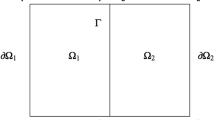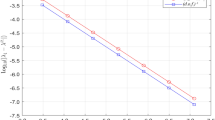Abstract
A domain decomposition method for large-scale elastic–plastic problems is proposed. The proposed method is based on a quasi-Newton method in conjunction with a balancing domain decomposition preconditioner. The use of a quasi-Newton method overcomes two problems associated with the conventional domain decomposition method based on the Newton–Raphson method: (1) avoidance of a double-loop iteration algorithm, which generally has large computational complexity, and (2) consideration of the local concentration of nonlinear deformation, which is observed in elastic–plastic problems with stress concentration. Moreover, the application of a balancing domain decomposition preconditioner ensures scalability. Using the conventional and proposed domain decomposition methods, several numerical tests, including weak scaling tests, were performed. The convergence performance of the proposed method is comparable to that of the conventional method. In particular, in elastic–plastic analysis, the proposed method exhibits better convergence performance than the conventional method.





































Similar content being viewed by others
References
ADVENTURE Project. URL http://adventure.sys.t.u-tokyo.ac.jp/
Akiba H, Ohyama T, Shibata Y, Yuyama K, Katai Y, Takeuchi R, Hoshino T, Yoshimura S, Noguchi H, Gupta M, Gunnels JA, Austel V, Sabharwal Y, Garg R, Kato S, Kawakami T, Todokoro S, Ikeda J (2006) Large scale drop impact analysis of mobile phone using ADVC on Blue Gene/L. In: Proceedings of the 2006 ACM/IEEE conference on supercomputing, pp 1–26
An HB (2005) On convergence of the additive Schwarz preconditioned inexact Newton method. SIAM J Numer Anal 43(5):1850–1871
Badea L (1991) On the Schwarz alternating method with more than two subdomains for nonlinear monotone problems. SIAM J Numer Anal 28(1):179–204
Bathe KJ, Cimento AP (1980) Some practical procedures for the solution of nonlinear finite element equations. Comput Methods Appl Mech Eng 22(1):59–85
Bhardwaj M, Day D, Farhat C, Lesoinne M, Pierson K, Rixen D (2000) Application of the FETI method to ASCI problems–scalability results on 1000 processors and discussion of highly heterogeneous problems. Int J Numer Methods Eng 47(1–3):513–535
Bhardwaj M, Pierson K, Reese G, Walsh T, Day D, Alvin K, Peery J, Farhat C, Lesoinne M (2002) Salinas: A scalable software for high-performance structural and solid mechanics simulations. In: Proceedings of the 2002 ACM/IEEE conference on supercomputing, pp 1–19
Cai XC, Keyes DE (2002) Nonlinearly preconditioned inexact Newton algorithms. SIAM J Sci Comput 24(1):183–200
Crisfield M (1979) A faster modified Newton–Raphson iteration. Comput Methods Appl Mech Eng 20(3):267–278
Degroote J, Bathe KJ, Vierendeels J (2009) Performance of a new partitioned procedure versus a monolithic procedure in fluid-structure interaction. Comput Struct 87(11–12):793–801
Dohrmann C (2003) A preconditioner for substructuring based on constrained energy minimization. SIAM J Sci Comput 25(1):246–258
Dolean V, Gander MJ, Kheriji W, Kwok F, Masson R (2016) Nonlinear preconditioning: How to use a nonlinear Schwarz method to precondition Newton’s method. SIAM J Sci Comput 38(6):A3357–A3380
Dryja M, Hackbusch W (1997) On the nonlinear domain decomposition method. BIT Numer Math 37(2):296–311
Farhat C, Lesoinne M, LeTallec P, Pierson K, Rixen D (2001) FETI-DP: a dual-primal unified FETI method–part I: a faster alternative to the two-level FETI method. Int J Numer Methods Eng 50(7):1523–1544
Farhat C, Roux FX (1991) A method of finite element tearing and interconnecting and its parallel solution algorithm. Int J Numer Methods Eng 32(6):1205–1227
Fish J (1992) The s-version of the finite element method. Comput Struct 43(3):539–547
Geradin M, Idelsohn S, Hogge M (1981) Computational strategies for the solution of large nonlinear problems via quasi-Newton methods. Comput Struct 13(1):73–81
Gosselet P, Rey C (2006) Non-overlapping domain decomposition methods in structural mechanics. Arch Comput Methods Eng 13(4):515–572
Hisada T, Noguchi H (1995) Foundation and application of nonlinear finite element method (in Japanese). Maruzen Publishing, Yokohama
Karypis G, Kumar V (1998) A fast and high quality multilevel scheme for partitioning irregular graphs. SIAM J Sci Comput 20(1):359–392
Kelley CT (2003) Solving nonlinear equations with Newton’s method. Society for Industrial and Applied Mathematics. https://doi.org/10.1137/1.9780898718898
Klawonn A, Lanser M, Rheinbach O (2014) Nonlinear FETI-DP and BDDC methods. SIAM J Sci Comput 36(2):A737–A765
Klawonn A, Lanser M, Rheinbach O, Uran M (2017) Nonlinear FETI-DP and BDDC methods: a unified framework and parallel results. SIAM J Sci Comput 39(6):C417–C451
Lui SH (1999) On Schwarz alternating methods for nonlinear elliptic PDEs. SIAM J Sci Comput 21(4):1506–1523
Mandel J (1993) Balancing domain decomposition. Commun Numer Methods Eng 9(3):233–241
Matthies H, Strang G (1979) The solution of nonlinear finite element equations. Int J Numer Methods Eng 14(11):1613–1626
Minami S, Yoshimura S (2010) Performance evaluation of nonlinear algorithms with line-search for partitioned coupling techniques for fluid-structure interactions. Int J Numer Methods Fluids 64(10–12):1129–1147
Miyamura T, Noguchi H, Shioya R, Yoshimura S, Yagawa G (2002) Elastic-plastic analysis of nuclear structures with millions of DOFs using the hierarchical domain decomposition method. Nucl Eng Des 212(1–3):335–355
Nayak GC, Zienkiewicz OC (1972) Note on the ‘alpha’-constant stiffness method for the analysis of non-linear problems. Int J Numer Methods Eng 4(4):579–582
Negrello C, Gosselet P, Rey C, Pebrel J (2016) Substructured formulations of nonlinear structure problems—influence of the interface condition. Int J Numer Methods Eng 107(13):1083–1105
Nikishkov GP, Atluri SN (1994) An analytical-numerical alternating method for elastic-plastic analysis of cracks. Comput Mech 13(6):427–442
Nishikawa H, Serizawa H, Murakawa H (2007) Actual application of FEM to analysis of large scale mechanical problems in welding. Sci Tech Weld Join 12(2):147–152
Ogino M, Shioya R, Kanayama H (2008) An inexact balancing preconditioner for large-scale structural analysis. J Comput Sci Tech 2(1):150–161
Ogino M, Shioya R, Kawai H, Yoshimura S (2005) Seismic response analysis of nuclear pressure vessel model with ADVENTURE system on the Earth Simulator. J Earth Simul 2:41–54
Pebrel J, Rey C, Gosselet P (2008) A nonlinear dual-domain decomposition method: application to structural problems with damage. Int J Multiscale Comput Eng 6(3):251–262
Pyo CR, Okada H, Atluri SN (1995) An elastic–plastic finite element alternating method for analyzing wide-spread fatigue damage in aircraft structures. Comput Mech 16(1):62–68
Smith B, Bjørstad P, Gropp W (2004) Domain decomposition: parallel multilevel methods for elliptic partial differential equations. Cambridge University Press, Cambridge
Toselli A, Widlund O (2004) Domain decomposition methods: algorithms and theory. Springer, Berlin
Xu J, Zou J (1998) Some nonoverlapping domain decomposition methods. SIAM Rev 40(4):857–914
Yoshimura S, Shioya R, Noguchi H, Miyamura T (2002) Advanced general-purpose computational mechanics system for large-scale analysis and design. J Comput Appl Math 149(1):279–296
Yumoto Y, Yusa Y, Okada H (2016) Element subdivision technique for coupling-matrix-free iterative s-version FEM and investigation of sufficient element subdivision. Mech Eng J 3(5):16–00361
Yumoto Y, Yusa Y, Okada H (2016) An s-version finite element method without generation of coupling stiffness matrix by using iterative technique. Mech Eng J 3(5):16-00001
Yusa Y, Kataoka S, Kawai H, Yoshimura S (2012) Large-scale fracture mechanics analysis using partitioned iterative coupling algorithm (in Japanese). Trans Jpn Soc Mech Eng Ser A 78(791):966–975
Yusa Y, Okada H, Yumoto Y (2017) Three-dimensional elastic analysis of a structure with holes using accelerated coupling-matrix-free iterative s-version FEM. Int J Comput Methods. https://doi.org/10.1142/S0219876218500366
Yusa Y, Yoshimura S (2013) Mixed-mode fracture mechanics analysis of large-scale cracked structures using partitioned iterative coupling method. Comput Model Eng Sci 91(6):445–461
Yusa Y, Yoshimura S (2014) Speedup of elastic–plastic analysis of large-scale model with crack using partitioned coupling method with subcycling technique. Comput Model Eng Sci 99(1):87–104
Acknowledgements
The present study was supported in part by MEXT Post-K Project Priority Issue 6: Accelerated Development of Innovative Clean Energy Systems and by JSPS KAKENHI Grant Number JP16K05988. The authors would like to thank the members of the ADVENTURE Project for their helpful discussions.
Author information
Authors and Affiliations
Corresponding author
Additional information
Publisher's Note
Springer Nature remains neutral with regard to jurisdictional claims in published maps and institutional affiliations.
Rights and permissions
About this article
Cite this article
Yusa, Y., Okada, H., Yamada, T. et al. Scalable parallel elastic–plastic finite element analysis using a quasi-Newton method with a balancing domain decomposition preconditioner. Comput Mech 62, 1563–1581 (2018). https://doi.org/10.1007/s00466-018-1579-4
Received:
Accepted:
Published:
Issue Date:
DOI: https://doi.org/10.1007/s00466-018-1579-4




